Acoustics at the University of Poznań (1918-2020)

Acoustics deals with the generation and propagation of elastic waves and the effects of their interaction with man and matter. Impact on humans means the perception of speech, music, noise and other sounds. What laws govern the emission of an acoustic wave by a vibrating piano plate? What happens to this wave in a concert hall? How is the impression of musical sound created in the human brain? These are some examples of solved and unsolved acoustic problems.
A modern university is supported by two pillars, teaching and learning. Taking the first of these into account, it can be said that acoustics has existed at the University of Poznan for 100 years i.e. as long as there have been majors in physics and musicology. On the second floor of the Collegium Minus on Mickiewicz Square, in the Department of Experimental Physics, exercises for beginners and advanced students were conducted since 1919 (Mathematics, Physics and Chemistry at the University of Poznan, A. Mickiewicz University in Poznan, Series: Works on the History of the University, no.9, 1971). Laboratory exercises with the so-called Quincke tube and the Kundt tube belonged to the canon of those days. In both exercises, wave interference increases the amplitude of the speed of air vibrations. Therefore, in the Quincke tube, the change in the loudness of the acoustic signal is recorded, and in the Kundt tube, the regular structure of the sand grains, which is shaped by the standing wave, is observed. Since the head of the plant Prof. A. Denizot (1873-1937) had a book by J. Tyndall (Sound, Longmans, London, 1867) with a very detailed description of both of these exercises, therefore it is legitimate to assume that physics students had been performing these exercises since 1919, i.e. since the beginning of our university. It is worth mentioning at this point that M. Wojciechowski’s master’s thesis, completed under the supervision of Prof. A. Denizot, dealt with inaudible waves with frequencies exceeding 20,000Hz. Since 1920, lectures on acoustics were given by Prof. T. Pęczalski (1891-1947) – head of the Department of Theoretical Physics.
Not only physicists, but also musicologists learned acoustics. As early as the fall semester of 1919, Rev. Dr. W. Gieburowski (1878-1943), as part of his lecture Theory and History of Music, spoke about musical scales, i.e., the relationship between the measurable frequency of a signal and the perceived pitch. In the first and second trimesters of the 1920/21 academic year, the title of this lecture was changed to Issues in Musical Aesthetics and Acoustics. In 1923, Professor L. Kamienski (1885-1964) took over this lecture.
A Handbook of Physics for Physicists, Pharmacists and Biologists (Academic Bookstore, Poznan), written by Prof. S. Kalandyk (1885-1940), was published in 1934. One of the chapters describes mechanical vibrations, the characteristics of the human voice and discusses the nature of sound audibility. So, before 1939, not only physicists and musicologists, but also medics, pharmacists and biologists were learning acoustics.
In 1936, the second pillar of university activity in acoustics emerged, i.e. scientific activity. In the Polish Yearbook of Musicology (Volume 2, pages 35-41), Marek Kwiek (1913-1962) – a lecturer at our university – published a paper entitled Resonance factors in timbre. This work treats the physical, psychological and physiological nature of musical timbre. The opposite of a “desirable” musical sound is noise – an “undesirable” sound. In the same year, 1936, M. Kwiek participated in the Meeting of the International Committee to Combat Noise at the League of Nations in Geneva. The subject of the paper was Scientific methods of combating noise. Today – in 2019, at the Institute of Acoustics we deal with audible waves (including noise, speech and music) and inaudible waves (ultrasound). Such a wide range of research is a lasting vestige of Prof. M. Kwiek’s activities.
In the same annus mirabilis 1936, a commission composed of professors from the University of Poznan (musicologist Ł. Kamieński, psychologist S. Błachowski and physicist A. Denizot) positively evaluated the doctoral thesis of M. Kwiek. The first of them wrote that the doctoral student “is a clearly defined scientific individual, with an impetuous thrust and uncommon inventiveness, who has an inclination towards strict mathematical and natural methods.” Further years confirmed this opinion.
After the war, in 1946, Dr. M. Kwiek’s study entitled Organs of the Kielce-Sandomierz Land became the subject of a habilitation dissertation. Thanks to the kindness of Prof. Sz. Szczeniowski (1898-1979) – head of the Department of Experimental Physics, in 1946, ad personam, an Acoustics Laboratory was established (2 rooms in the Collegium Chemicum at 6 Grunwaldzka Street). When doc. M. Kwiek was joined by Dr. E. Karaśkiewicz (1899 -1973), M.Sc. H. Ryffert (1916-1996) and M.Sc. H. Harajda (1921-2011), in 1952 the laboratory moved to 5 rooms in Collegium Maius (Fredry 10) and became the Department of Acoustics and Vibration Theory. Then one of the rooms was adapted into the first anechoic cabin in Poland. In 1956, the Department became the Department of Acoustics and Vibration Theory. After the tragic death of Prof. M. Kwiek in 1962 and the departure of Prof. E. Karaśkiewicz to Poznan University of Technology, the management of the Department of Acoustics was entrusted to Prof. Halina Ryffert. On the initiative of our professors, the Polish Acoustical Society was founded in 1963 (with the main board at the Department of Acoustics), and in 1964 the Committee on Acoustics at the Polish Academy of Sciences was established.
Experimental work in molecular acoustics (at our university) began with the work of A. Sliwinski (Proceeding of the 2-nd Ultrasonic Conf. Miedzyzdroje, 1956). His habilitation and the dynamic development of the group around him (interaction of ultrasound with light and molecules of the medium) led in 1966 to the separation of the Department of Molecular Acoustics as part of the Department of Acoustics. At the invitation of the organizers of the emerging university, in 1970 Doc A. Sliwinski moved to Gdansk, but “part of his heart remained in Poznan.” He did not stop his contacts with the Department headed by Prof. H. Ryffert, and later with the Institute of Acoustics. Prof. A. Sliwinski helped and supported not only those who dealt with ultrasound.

From left: R.Urbański, M.A., Prof. J.Stefaniak, Prof. A.Śliwiński, Prof. I.Malecki, K.Mlicka, Prof. Z.Jagodziński, Prof. A.Rakowski, Prof. H.Harajda
In 1974, the Department of Acoustics was moved to the Collegium Matematicum at 48/49 Matejki St. We obtained 15 rooms there. There was also an anechoic cabin and other teaching and laboratory rooms. Since 1999, we have been working in 30 rooms in the beautiful Collegium Physicum on the Morasko Campus. We have the largest anechoic cabin in Poland, we have well-equipped 2 recording studios and a sufficient number of lecture halls and laboratories.
Let’s go back to the past. In 1985, the Department of Acoustics became the Institute of Acoustics with four departments:
Molecular Acoustics (doc. M. Labowski),
Environmental Acoustics (doc. R. Makarewicz),
Electroacoustics (doc. E. Hojan),
Psychoacoustics and Room Acoustics (doc. E. Ozimek).
Since then, the directors of the Institute were Professors E. Ozimek, E. Hojan, M. Łabowski, R. Makarewicz and P. Miecznik, and again R. Makarewicz.
Currently, the director of the Department of Acoustics is Prof. UAM Dr. Roman Golebiewski, Dean of the Faculty of Physics at UAM.
In the beginning, the Laboratory, the Department, then the Department and finally the Institute of Acoustics, were part of first the Faculty of Mathematics, Physics and Chemistry, then the Faculty of Mathematics and Physics. Currently, we operate as part of the Faculty of Physics. The post of Vice-Dean of the above-mentioned faculties was also held by acoustics associate professors M. Kwiek, H. Ryffert, R. Makarewicz, M. Łabowski and P. Miecznik. On the other hand, the high office of Faculty Dean was held by Professors H. Ryffert and R. Makarewicz. Currently, this function is held by Prof. R. Golebiewski.
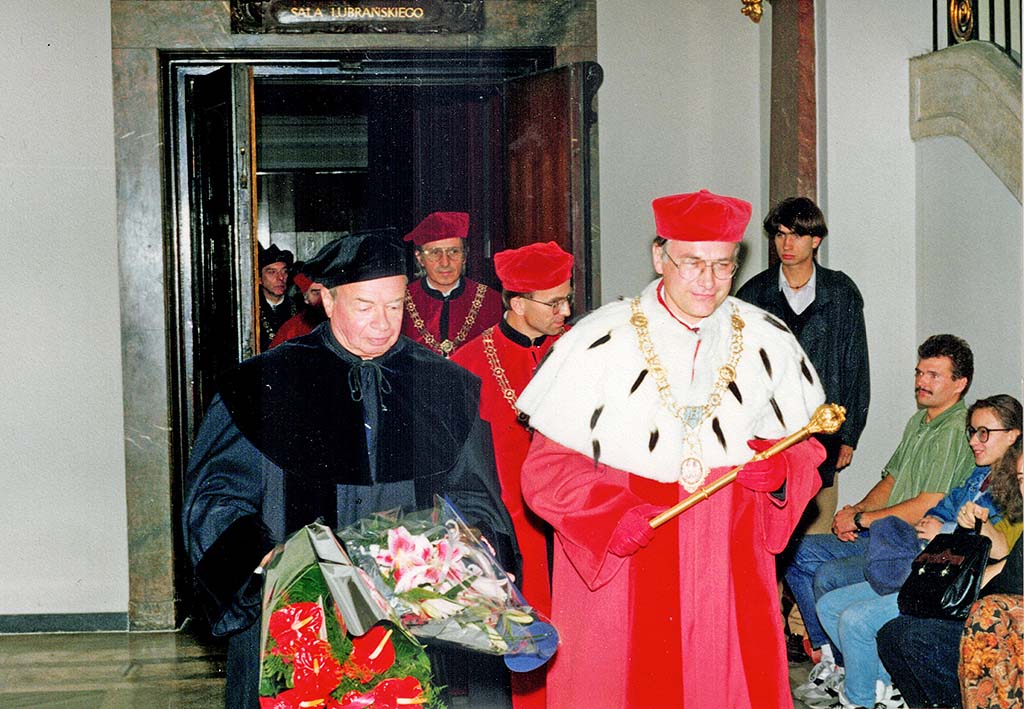
Dean of the Faculty of Physics and Mathematics Prof. R.Makarewicz.
Long ago, our predecessors dealt with vibrations of strings, membranes, rods, elastic surfaces and three-dimensional objects. Since they are sources of acoustic waves, therefore the theory of vib rations (M. Kwiek, E. Karaśkiewicz, S. Augustyniak, E. Hojan, Cz. Cempel) can be considered part of acoustics in the broadest sense. Sources of waves are also air vibrations in acoustic resonators. Such resonators are the interiors of stringed instruments, rooms with open windows, “talking” or “singing” mouths, etc., etc..
At a distance far beyond the linear dimensions of a resonator (e.g., a violin) or an oscillating surface (e.g., a speaker diaphragm), a spherical wave appears, for which the real source becomes a point source. Similarly, a cylindrical wave is recorded at a large distance from a set of densely packed point sources (e.g., vehicles on the road). The description of real acoustic waves gets complicated when they interfere with each other, either waves scattered by an inhomogeneous medium, or waves reflected from the surface of the ground, the walls of a room, etc. Thus, another branch of acoustics called acoustic field theory (M. Kwiek, E. Karaskiewicz, H. Ryffert, R. Wyrzykowski, J. Fazanowicz, R. Makarewicz, T. Hornowski) was emerging at the Department in the 1950s.
Vibrations of the diaphragm of a loudspeaker or headphone convert an electrical signal into an acoustic signal, and vibrations of the diaphragm of a microphone reverse this process. The principles of loudspeakers and microphones, as well as methods of measuring acoustic waves and electrical signals, belong to electroacoustics. Research in this area was conducted by Prof. M. Kwiek and his successors (J. Fazanowicz, E. Hojan, J. Florkowski, M. Niewiarowicz, P. Perz, N. Kelani, M. Wojtczak, E. Skrodzka, P. Pękala). The Institute of Acoustics worked closely with the Tonsil Loudspeaker Manufacturing Plant in Września. Problems and questions arising there found answers in scientific papers and theses. These were carried out by physics students who specialized in acoustics in their fourth and fifth years. In the 1980s, with Tonsil employees in mind, the Institute of Acoustics organized a postgraduate course on the Basics of Electroacoustics.
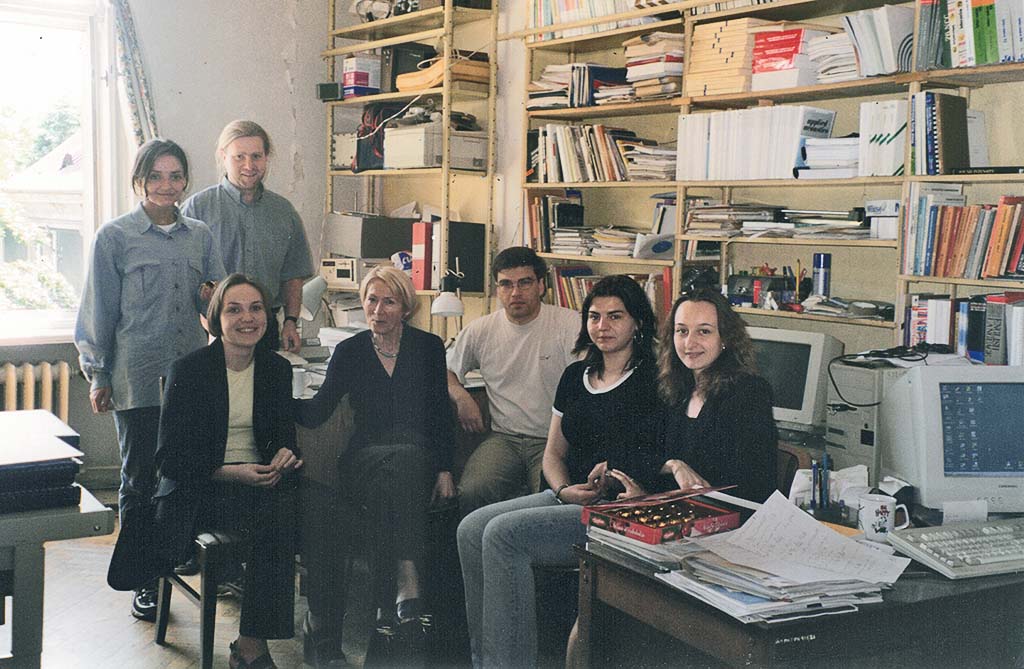
Prof. U.Jorasz, Dr. R.Golębiewski and Dr. P.Kokowski with master’s students.
In the early 1990s, there was a rapid increase in the number of hearing aids and a consequent need to educate relevant professionals. At first, the institute conducted further training courses in hearing aids. Then, on the initiative of Prof. E. Hojan and with the great commitment of Dr. A. Furmann, a 3-year vocational study of hearing prosthetics was established in 1992. The Medical Academy in Poznan and the German company Geers – a distributor of hearing aids – had a great share in this undertaking. At this point it is necessary to return once again to Prof. M. Kwiek, who wrote much earlier: “on the ground of work on loudness, the possibility of establishing the principle of designing hearing prostheses adapted to the existing auditory residuals opens up, thus relieving many handicapped members of society.” Truly these were prophetic words! The study of hearing aids and methods of fitting them marked a shift from classical electroacoustics (speakers and microphones) to hearing aid acoustics, viz. micro-electroacoustics enriched with psychoacoustics and audiology (E. Hojan, M. Niewiarowicz, A. Furmann, R. Ewertowski, P. Pękala, M. Wojtczak, E. Skrodzka, A. Wicher, R. Golębiewski, J. Modlawska, K. Mrugalska, M. Stieler, A. Duraj).
The pioneering research of 1936 (see above) concerned auditory impressions, i.e. psychoacoustics (M. Kwiek, H. Ryffert, T. Kwiek-Walasiak, E. Ozimek, E. Hojan, M. Szygulska, G. Kerber, U. Jorasz, A. Czajkowska, J. Florkowski). Its origins are associated with the simplest signal: a tone of constant amplitude and frequency. More information about the mechanisms of perception is provided by sounds composed of several tones and noises (collections of densely packed tones). Even more information (among other things, about the nonlinearity of the sense of hearing) is obtained using signals with time-varying amplitudes and frequencies. Due to the random fluctuations of impressions with identical signals, the quantitative description of sound detection and discrimination requires borrowing from probability theory and fuzzy set theory (S. Prus, K. Mlicka)

Prof. J.Jorasz, pof. A.Preis, MA I.Krasowska, Dr. J.Jarzęcki, Prof. R.Makarewicz.
The Department of Acoustics practiced speech acoustics (M. Kwiek, E. Ozimek, E. Hojan, J. Peikert, J. Konieczny) concerning the voice (the most important means of information exchange) and singing (the most natural form of music). The fundamental question of how these sounds are created has not yet found a definitive answer. We are constantly looking for ways to better understand speech in noise, with minor and major hearing loss.
Multiple reflections and scattering of acoustic waves in apartments, temples, school halls and auditoriums reduce speech intelligibility. The same phenomena in concert halls prevent faithful reproduction of musical notation, and in industrial halls increase the annoyance of noise. Each room modifies the signal spectrum (M. Kwiek, H. Ryffert, S. Przygórzewski, E. Ozimek), and the time course (including the final transient) determines the intelligibility of speech and music. The question of how this can be remedied is answered by interior acoustics (M. Kwiek, E. Karaśkiewicz, A. Śliwiński, E. Ozimek, E. Hojan, W. Małecki, L. Rutkowski, L. Jugowar, M. Miszuda, P. Pękala).
When the noise is generated by a source located inside the building, where people work or rest and sleep, then we are dealing with industrial or construction noise (M. Kwiek, E. Karaśkiewicz, A. Śliwiński, E. Ozimek, E. Hojan, M. Łabowski, J. Fazanowicz, S. Augustyniak, L. Rutkowski). When the sources of noise are outside the building (road vehicles, rail vehicles, airplanes, wind turbines, etc.), then one speaks of environmental acoustics. In the Department and Institute, environmental noise measurements were carried out, especially noise of the largest cities in Poland (M. Kwiek, H. Ryffert, E. Ozimek, E. Hojan, G. Kerber, J. Jarzęcki, L. Rutkowski, I. Krasowska, P. Kokowski, R. Golębiewski, T. Kaczmarek, M. Galuszka ). So far, in the Department of Environmental Acoustics, we are dealing with all types of noise (see below). In order to maximally shorten the path from the results of our own noise research to practical applications, in 2000 we expanded the Professional Studies in Hearing Prosthetics and transformed it into a 3-year Bachelor’s Degree in Hearing Prosthetics and Noise Protection.
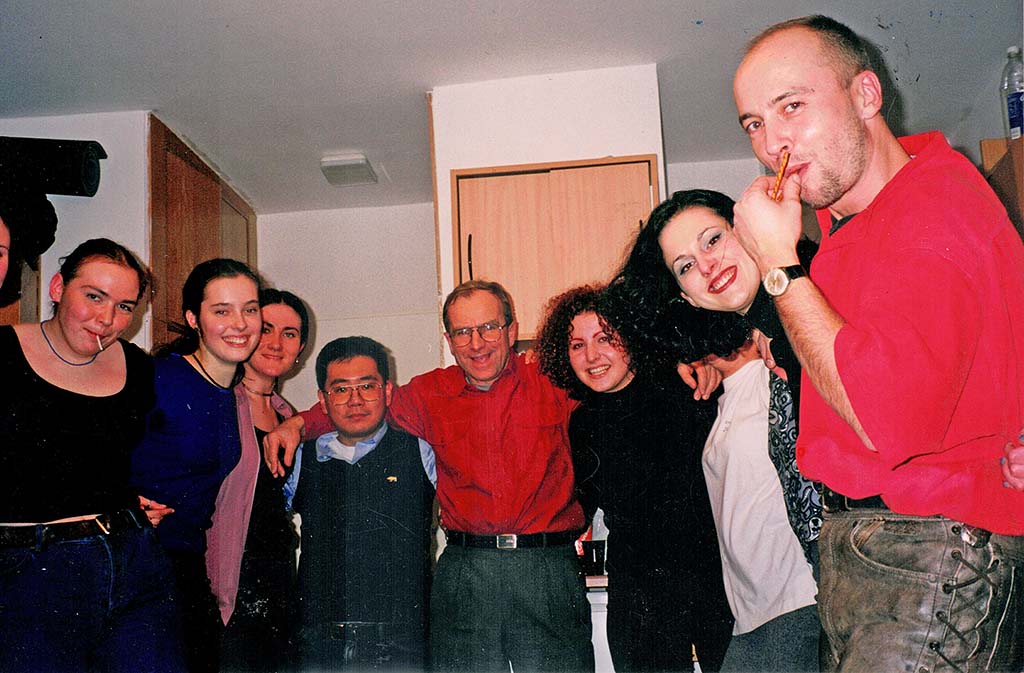
The subject matter of the Department of Environmental Acoustics, headed by Prof. A. Preis, concerns the annoyance of noise generated by single sources (A. Preis, T. Kaczmarek, H. Hafke-Dys) and by collections of sources, an example of which is urban noise (J. Felcyn). The subject of research is also the propagation of road and rail noise (R. Makarewicz, R. Golębiewski) and the generation, propagation and perception of wind turbine noise (R. Makarewicz, A. Preis, R. Golębiewski, P. Kokowski). Auditory-visual interaction, very important for the perception of the human environment, is dealt with by A. Preis, H. Hafke-Dys and J. Felcyn. This work was funded by the National Science Center, the Polish-Norwegian Fund for Scientific Research and the European Commission. The results of the research conducted by H. Hafke-Dys concern the sounds generated by people suffering from respiratory diseases. Prof. A. Preis was a fellow of the Humbolt Foundation (Germany) and worked for several years in Sweden and Japan. Prof. R. Makarewicz was also a Humboldt Foundation Fellow in Germany and, in addition, spent 4 years (intermittently) teaching and conducting research in the USA and Japan. The Department of Environmental Acoustics was the organizer of the National Workshop on Wind Turbine Noise (about 50 people) and training for state and local government employees on urban noise (about 30 people).
The Department of Electroacoustics, headed by Prof. E. Skrodzka, conducts research in the field of assisting people with hearing and visual problems with electroacoustic methods (E. Hojan, A. Furmann, E. Bogusz-Witczak, A. Schelenz). This research is interdisciplinary and includes classical electroacoustics, hearing aid acoustics, speech acoustics, psychoacoustics and digital signal processing. The result of this research is, among other things, a method for teaching spatial orientation to blind and visually impaired people, which is based on acoustic training and the use of a sound library of acoustic events. In the past few years, three research projects funded by the National Science Center and the National Center for Research and Development have been carried out at the facility. Porf. E. Hojan was a Humboldt Fellow in Munich and Bochum, and Prof. E. Skrodzka was on a one-year internship in Munich.
The Department of Indoor Acoustics and Psychoacoustics, headed by Prof. A. Sek, deals with the functioning of the auditory system (E. Ozimek, A. Wicher, J. Konieczny, E. Tarnowska), i.e. models of sound perception based on the classical theory of excitation of the basilar membrane and non-classical theory, related to phase synchronicity (assignment of neural impulses to the phase of the forcing wave). Acoustic otoemission, i.e. the generation of signals by the auditory system, is also a subject of research (A. Wicher). The facility also practices room acoustics (J. Kocinski) related to speech intelligibility (E. Ozimek, A. Wicher, D. Niemiec). Foreign contacts of the plant resulted in one-year scholarships of Prof. E. Ozimek in England and Japan and several years of activity of Prof. A. Sek in both countries.
Acousticians employed since 1947, first in the Laboratory, then in the Department and in the Department of Acoustics and Vibration Theory and finally in the Institute of Acoustics at A. Mickiewicz University, published the results of their research in about 1000 papers, scientific works and monographs. Almost everyone gave lectures or refereed their results abroad and received guests from abroad at their home in Poznan. The Institute of Acoustics has a dozen postdoctoral fellows and dozens of doctoral students. Two of them are honorary doctorates of our university, world-renowned scholars: Joseph J. Zwislocki of Syracuse University (USA) and Prof. Brian C.J. Moore of Cambridge University.
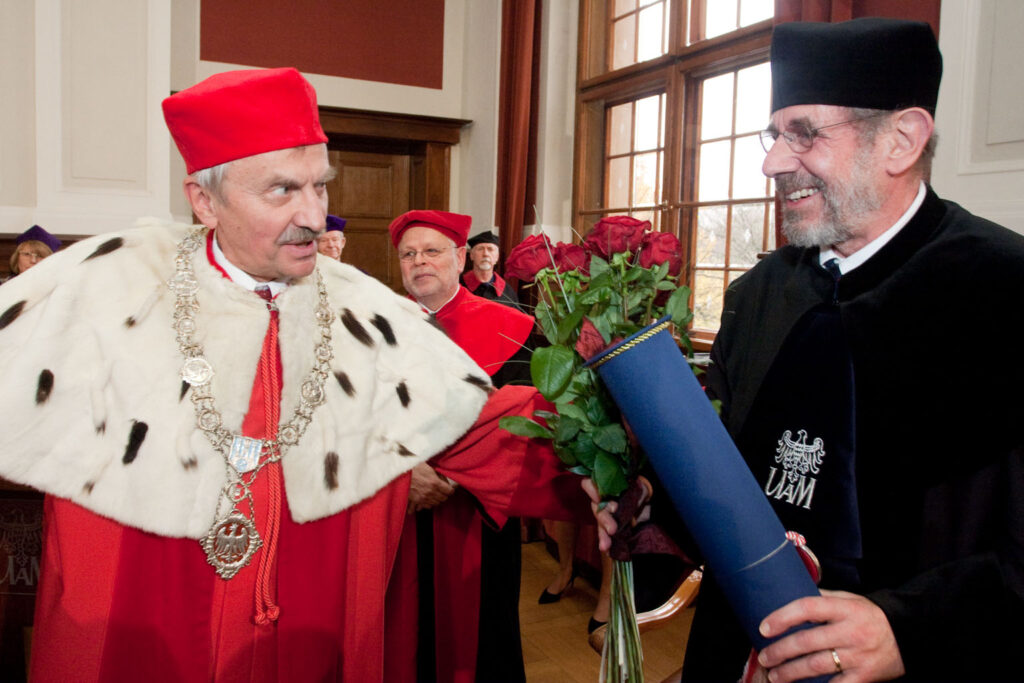
Behind the Recorder Prof. B.Marciniak the promoter Prof. A.Sęk. Photo by M.Męczyński
Currently, the members of the Acoustics Committee of the Polish Academy of Sciences are Professors A. Józefczak, A. Preis, A. Sęk and E. Skrodzka. The high stature of the Institute of Acoustics is evidenced by the fact that Prof. A. Józefczak is a member of the editorial board of Acta Acustica united with Acoustica, Prof. R. Makarewicz co-edits Applied Acoustics, Noise Mapping and the Journal of Aviation and Aeronautical, Prof. A. Preis is an editor in Archives of Acoustics and an active WHO expert, and Prof. E. Skrodzka edits the Acoustics section in Open Physics Sciences.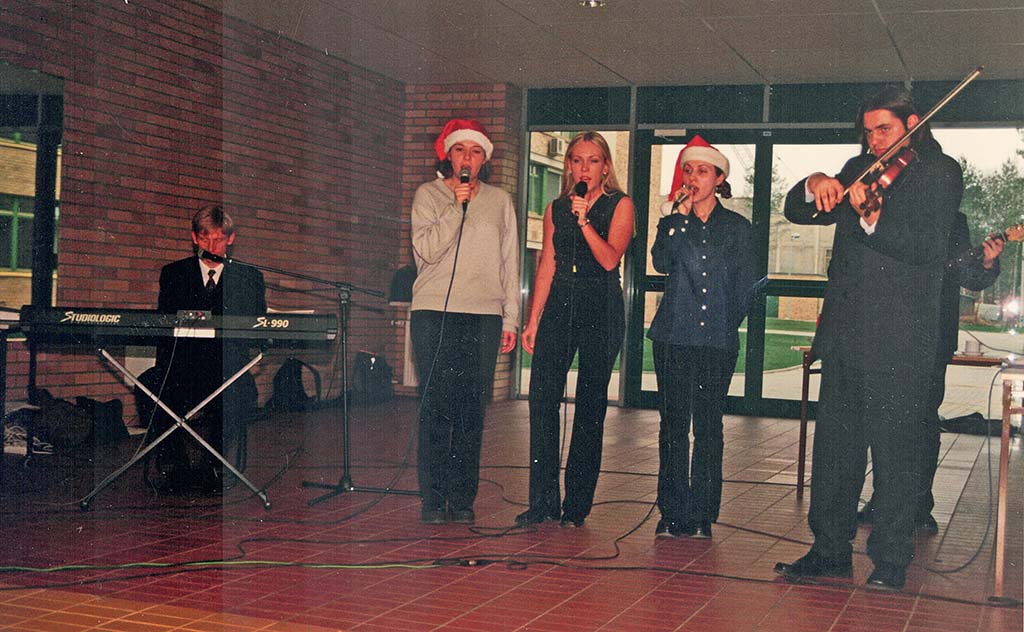
The didactic activities of the Institute of Acoustics include 3 types of studies: 1 master's and 2 bachelor's. The 3-year bachelor's degree program in Sound Direction graduates about 20 graduates each year. Professional sound processing, recording production, concert sound reinforcement, etc., enable them to find an attractive job in their learned profession. At the 3-year Bachelor's Degree in Hearing Prosthetics and Noise Protection, students learn methods of hearing diagnosis, hearing aid fitting, noise measurement, acoustic screen design, etc. Every year, about 20-odd graduates easily find rewarding jobs. In the Acoustics major, on the other hand, 15 students participate in scientific research each year through their master's theses.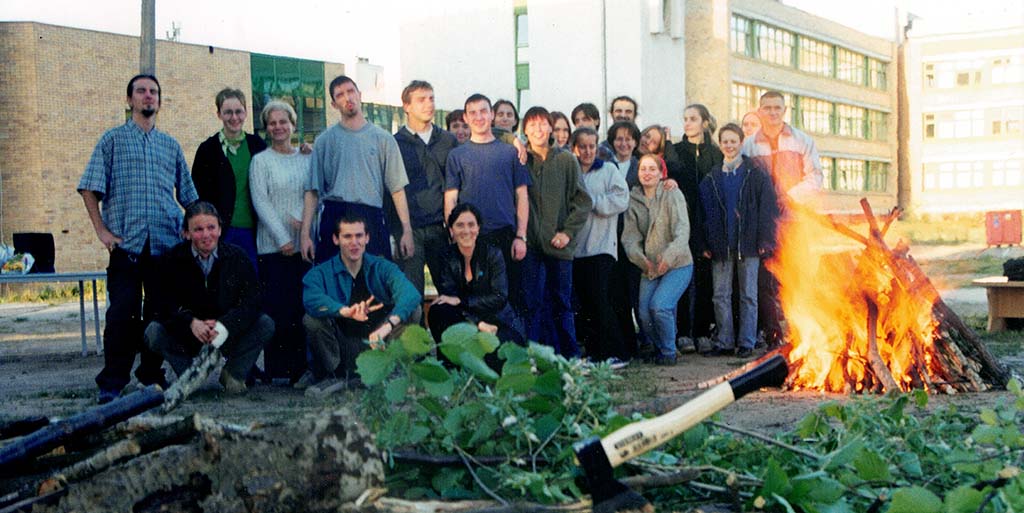
In 2020, the Institute of Acoustics became the Department of Acoustics, headed by Prof. R. Golebiewski.
PS. The author would like to sincerely thank Professors A. Sliwinski, E. Ozimek, E. Hojan, as well as the director of the Institute and the heads of the Departments for their help in editing the text.Author: Prof. Rufin Makarewicz, Ph.D.
Contact: makaaku [at] amu.edu.pl
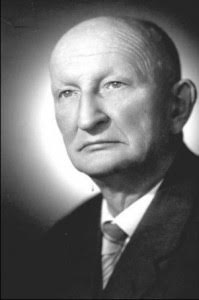
Edmund Karaśkiewicz (1899-1973)
After receiving his diploma as a teacher of mathematics and physics at the University of Poznan in 1929, he was a professor at the Copernicus Gymnasium in Bydgoszcz. In 1939, he fought against the Germans as a lieutenant in the 62nd infantry regiment of the Pomeranian Army. He devoted his time of captivity in a POW camp to mathematical studies, including tensor theory. From 1946, at the Poznan Engineering College and the University of Poznan, he taught mathematics, theoretical mechanics and the theory of vectors and tensors, while collaborating with Prof. M. Kwiek. In 1950, he received his doctorate in mathematical and natural sciences. From 1956 to 1962, he was an employee of the Department of Acoustics and Vibration Theory. In 1957 he became a professor, and from 1959 to 1962 he was head of this department. Member of several scientific societies and organizations. He promoted 10 doctoral students. Prof. E. Karaskiewicz was endowed with a noble passion for teaching, tremendous teaching and pedagogical talent.
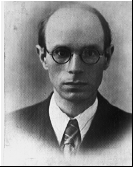
Marek Kwiek (1913-1962)
The founder of acoustics at the University of Poznan, with which he was associated throughout his adult life. His master’s degree (1934) and doctorate (1937) were related to musicology. He survived the war in the General Government, building and repairing organs. In 1946, the Humanities Department of our university accepted his habilitation, and nine years later he became a professor. Head of the Laboratory, Department and later the Department of Acoustics and Vibration Theory. Lecturer in a great many subjects, humanities and mathematical and natural sciences. Initiator of, among others, the Open Seminars in Acoustics – annual conventions of Polish acousticians. Member of several Polish and foreign scientific societies and organizations. He has promoted 6 doctoral students and participated in 10 habilitation chairs. He published 56 scientific papers and 10 textbooks and scripts. He was characterized by: focus, insight, precision, clarity of thought, a wealth of new concepts, and extensive knowledge to detect surprising analogies. He possessed a gift for generating enthusiasm for scientific work. With all this, he was very humble. He generously gave advice and shared ideas.

Halina Ryffert (1916-1996)
She associated her studies and professional work with the University of Poznan. In 1939 she received a master’s degree in mathematics. During the war she was active in the resistance movement against the German occupiers. Deconspiration led to imprisonment in Fort VII in Poznań and in the Ravensbruek concentration camp. From 1945 to 1951, she was employed first in the Department of Mathematics at the University of Poznan, then in the Department and Chair of Acoustics and Vibration Theory. In 1958 she received her doctorate, in 1961 the Faculty Council accepted her habilitation, and in 1968 the State Council conferred the title of professor. She has promoted 14 PhDs and participated in 4 habilitation chairs. A member of several scientific organizations and societies. She was head of the Department of Acoustics, vice dean and dean of the Faculty of Mathematics, Physics and Chemistry. It can be said that “her whole life” was the department, the faculty, our university.

